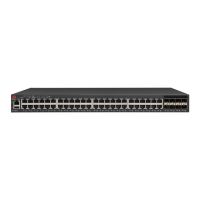
Do you have a question about the Arris Ruckus ICX 7850 Series and is the answer not in the manual?
| Product Series | ICX 7850 |
|---|---|
| Manufacturer | Arris Ruckus |
| Category | Switch |
| Switching Capacity | 6.4 Tbps |
| Throughput | 4.76 Bpps |
| Operating Temperature | 0°C to 40°C (32°F to 104°F) |
| Form Factor | Chassis |
| Port Options | 10 GbE |
| Power Supply | Redundant, hot-swappable power supplies |
| Cooling | Redundant, hot-swappable fan modules |
| Management | CLI, Web GUI, SNMP |
| Software | Ruckus FastIron |
| Layer 3 Features | OSPF, BGP, RIP, VRRP, PIM |
| Layer 2 Features | VLAN, STP, RSTP, MSTP |
| Security Features | ACLs, 802.1X, DHCP snooping |
| Monitoring and Analytics | sFlow, RMON, SNMP |
| Supported Transceivers | SFP, SFP+, SFP28, QSFP+, QSFP28 |
| Redundancy | Power supplies, fan modules |
Compares new and old behaviors for configuring stacking ports and trunks.
Recommends interactive-setup for constructing a stack, replacing secure-setup.
Describes zero-touch provisioning for automatic stack configuration.
Explains methods like interactive-setup, zero-touch provisioning, and manual config.
Details connection requirements for discovering new units using interactive-setup.
Provides steps to construct a stack using zero-touch provisioning with clean units.
Details creating stacking trunks on a live ICX 7150 system.
Explains how to create stacking trunks on an ICX 7450.
Shows how to form trunks using interactive-setup for ICX 7750.
Guides on configuring stacking links in a live production environment.
Guides creating a two-unit ICX 7850 stack with a linear-topology trunk.
Guides creating a two-unit ICX 7850 stack with a ring topology using zero-touch provisioning.
Introduces hitless stacking as a High Availability feature ensuring minimal data loss.
Details internal events during controlled or forced switchovers and failovers.
Describes the standby controller's role and shadowing behavior with hitless stacking.
Explains managing a stack via a single IP address for all management functions.
Explains the roles of active controller, standby controller, and stack member.
Discusses considerations for upgrading or downgrading stack software.
Explains types of mismatches (feature, image, config) and their effects.
Explains the Auto Image Copy feature for ensuring consistent software images.
Details creating or modifying trunks in a production environment using multi-stack-trunk.
Covers adding, removing, or replacing stack units using various methods.
Details how to return stack units to their pre-stacking state using `stack unconfigure`.
Lists common issues encountered during stack formation.
Provides steps to troubleshoot unsuccessful stack builds.
Provides basic checks for suspected hardware failures after an upgrade.